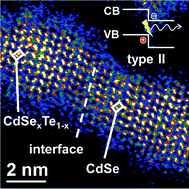CdSe–CdSexTe1−x nanorod heterostructures: tuning alloy composition and spatially indirect recombination energies†
Abstract
In exploiting enhanced/new properties of the emerging class of heterostructured

* Corresponding authors
a
Department of Materials Science and Engineering, University of Illinois, Urbana, Illinois 61801, USA
E-mail:
mshim@illinois.edu
In exploiting enhanced/new properties of the emerging class of heterostructured

 Please wait while we load your content...
Something went wrong. Try again?
Please wait while we load your content...
Something went wrong. Try again?
H. McDaniel, N. Oh and M. Shim, J. Mater. Chem., 2012, 22, 11621 DOI: 10.1039/C2JM31464A
To request permission to reproduce material from this article, please go to the Copyright Clearance Center request page.
If you are an author contributing to an RSC publication, you do not need to request permission provided correct acknowledgement is given.
If you are the author of this article, you do not need to request permission to reproduce figures and diagrams provided correct acknowledgement is given. If you want to reproduce the whole article in a third-party publication (excluding your thesis/dissertation for which permission is not required) please go to the Copyright Clearance Center request page.
Read more about how to correctly acknowledge RSC content.
 Fetching data from CrossRef.
Fetching data from CrossRef.
This may take some time to load.
Loading related content
